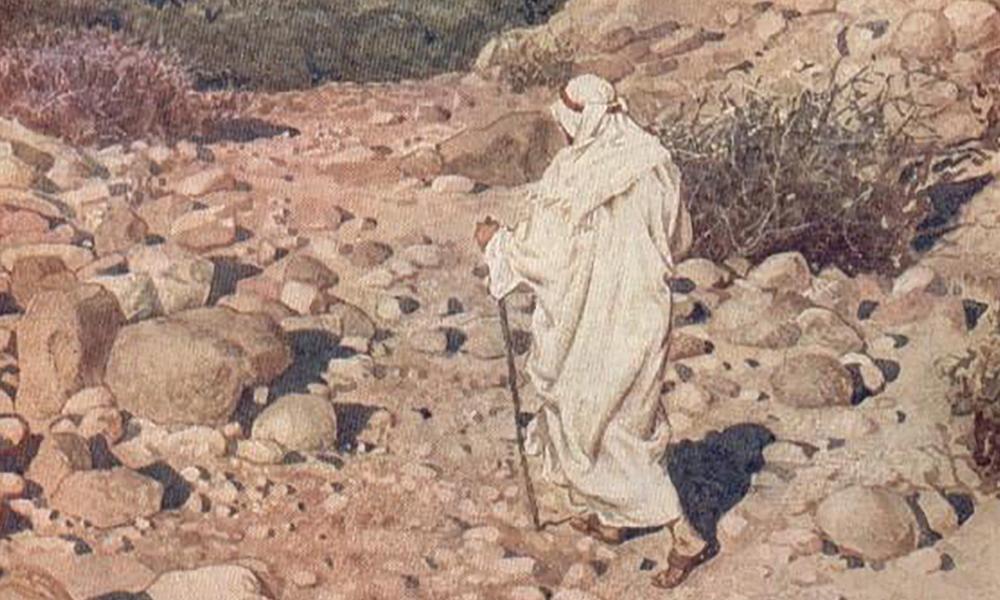
The Number 40
"Then Jesus was led by the Spirit into the desert to be tempted by the devil. He fasted for forty days and forty nights, and afterwards he was hungry." (Mt 4:1-2)
"Then Jesus was led by the Spirit into the desert to be tempted by the devil. He fasted for forty days and forty nights, and afterwards he was hungry." (Mt 4:1-2)
In the Bible, any time period that consists of the number 40 is significant. Periods of 40 typically begin with great acts of faith and involve numerous trials and tribulations, but they end with God’s transformation. It is an appropriate time to examine the importance of the number 40 as we prepare once again to enter into the 40 days of the Lenten season.
The journey of faith
While examples abound in the Scriptures, a few prominent stories will help illustrate the transformative power inherent in these various periods of 40. In each, there is an encounter with God and revealed truth. This encounter always calls for a response. The person who assents to the call of faith faces trials and tribulations that invite him or her to turn back and quit the journey. However, because the person persists in the face of adversity, doubt and even short-term failure, they emerge from their journey transformed and equipped to lead others along this same path.
From Noah to Moses
Let us consider the adventure of Noah. Noah lived at a time when wickedness was everywhere, so God decided to put an end to all life on earth with one exception, Noah. God called on Noah to build an ark in preparation for a great flood that God would send upon the world. Noah responded in belief and began the construction of the great ark. Of course, he was ridiculed by those around him. After all, who could believe such insanity? Nevertheless, Noah persisted and soon the rain began to fall. For 40 days and 40 nights, the water poured down from the heavens, flooding the earth and wiping out all living creatures. Only Noah and those on the ark survived the great flood. Noah and his crew of people and animals returned to not only reinhabit the earth, but to transform it through faithfulness to God.
Did You Know…
The catechism teaches us that the 40 days of Lent constitute the Church’s way of uniting herself to the mystery of Jesus in the desert. (CCC 540)
Later in the Old Testament, we are told that in Egypt the Israelites had been enduring for generations the trials and tribulations that characterize the lot of slaves, when God decided to liberate them. God called forth Moses – an exile on the run for having killed an Egyptian for maltreating a Hebrew slave. Moses chose to believe in God’s promise despite all odds and outward appearances to the contrary. Persevering through the refusals of the pharaoh and the subsequent plagues, Moses became God’s instrument of liberation, and the Israelites were delivered from their powerful Egyptian captors.
Of course, these same Israelites would wander in the desert eating manna for 40 years before God would transform them into a nation with a land of their own. During this long journey in the desert, Moses was commanded by God to climb Mt. Sinai. Moses spent 40 days and 40 nights on Mt. Sinai before descending with the stone tablets on which God had written the commandments intended for the people’s instruction. These tablets were later destroyed by Moses when he saw that the Israelites had turned away from God toward a golden calf in his absence. However, God called Moses back to Mt. Sinai for another 40 days and 40 nights of fasting while God redelivered the Law to Moses and transformed a lawless people into a covenantal people.
“Quotes” Quiz
Who said, “Nothing great is ever achieved without much enduring”?
A. Pope Francis
B. St. Teresa of Calcutta
C. St. Gregory the Great
D. St. Catherine of Siena
Answer at the end of this post
From the desert to the right hand of the Father
As we turn to the New Testament, we learn from our opening passage that Jesus Christ was led by the Spirit, after his baptism by John and before he began his public ministry, into the wilderness where he fasted for 40 days and 40 nights. It was during this time that Jesus was tempted to be self-sufficient, to try to manipulate God and to worship the devil instead of God. Of course, Jesus not only overcame these temptations, he emerged from his 40 days and 40 nights in the desert to forever change the world and the trajectory of history. The Incarnate Word of God transformed darkness into light by entering into our weakness and by demonstrating perfect obedience to God and total dependence on him alone.
This period prior to Jesus’ public ministry is mirrored by a 40-day period after the conclusion of this public ministry, which ended at the foot of the cross. Jesus appeared to his disciples for 40 days after the Resurrection before ascending into heaven. Jesus had faithfully and obediently submitted to the ultimate trial, and through it transformed death into life. He had overcome the cross through the Resurrection, showing a wounded humanity the eternal destiny that awaits those who love God.
Our 40 days
A great deal, indeed, can happen in periods of 40. The great gift we have been given with the season of Lent is an invitation to participate in this history of God’s transformative power. Each one of us can exit these 40 days prepared and positioned for the transformation of the Easter event. This requires that we trust in and stand on the Word of God even when it might lead to our being ridiculed or misunderstood; that we be brutally honest with ourselves about what parts of our life must be left behind because they keep us enslaved to sin and wickedness; that we show the courage to venture into the desert of Lent led only by faith in God; and that we die to our ego and submit instead to the will of God. This is indeed the great lesson of Lent: Transformation is preceded by and prepared for through prayer, penance, fasting and self-denial.
Answer to the "Quotes" quiz: St. Catherine of Siena
Doug Culp is the CAO and secretary for pastoral life for the Diocese of Lexington, Kentucky. He holds an MA in theology from Catholic Theological Union in Chicago.
This article was originally published March 2022.


